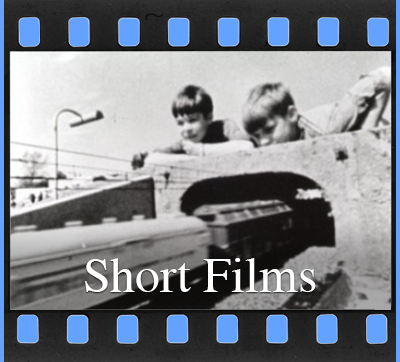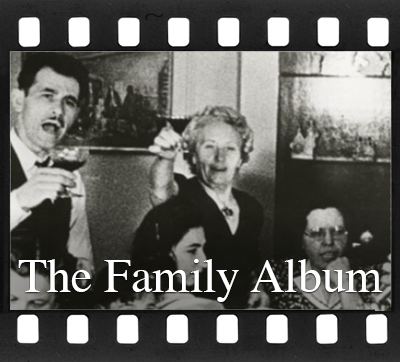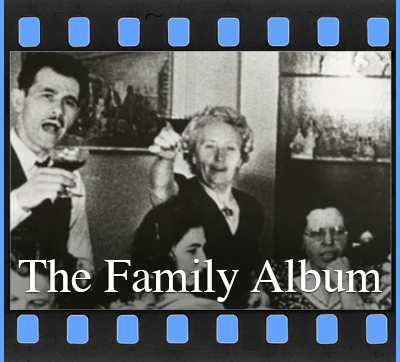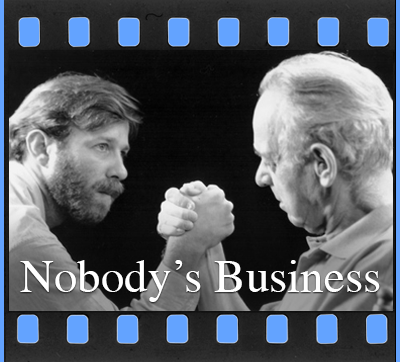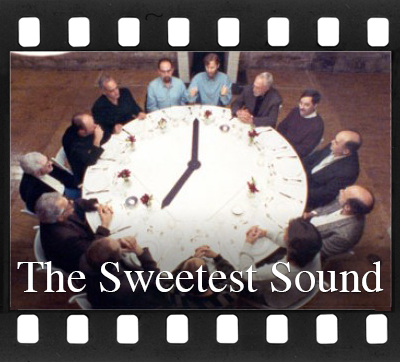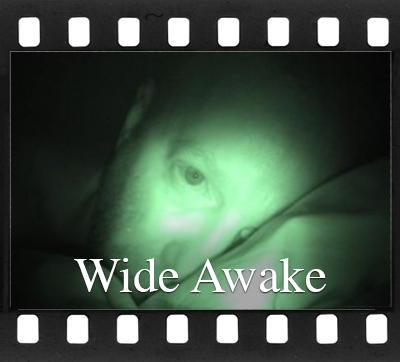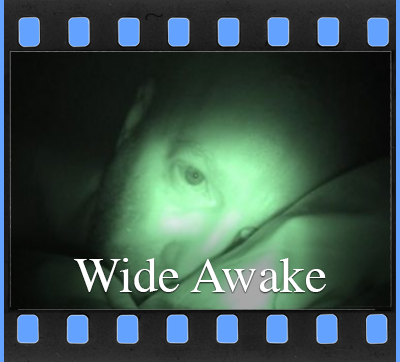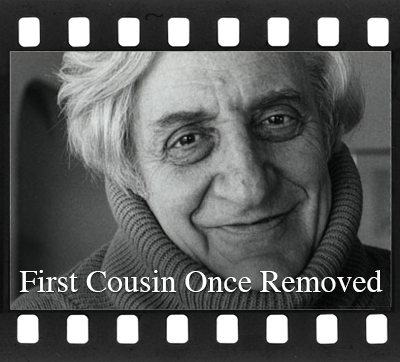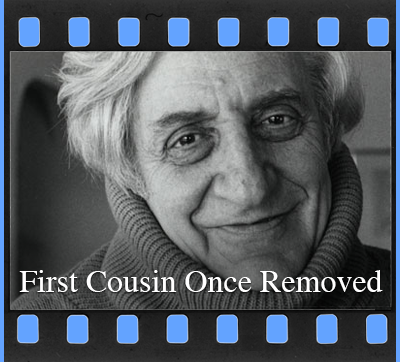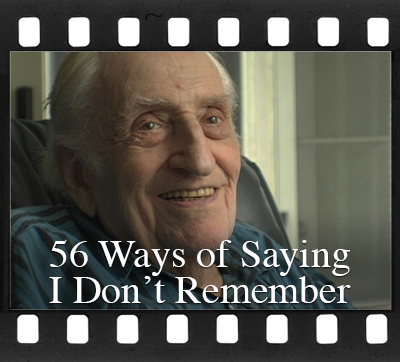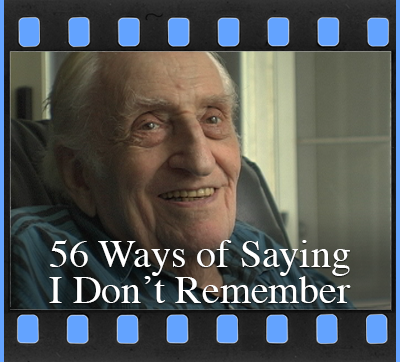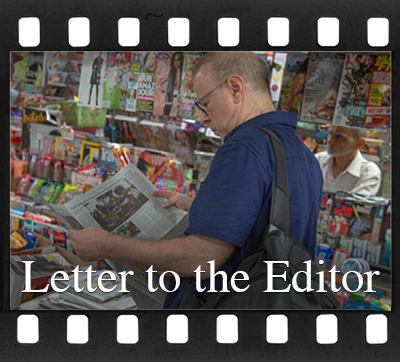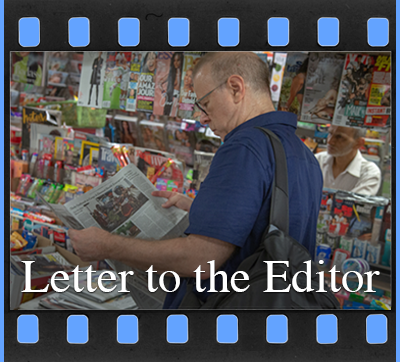Family Secrets:
Alan Berliner’s Nobody’s Business and the Jewish Autobiographical Film
by Michael Renov
In loving memory: Max H. Renov (1921-2005)
Jews have always cared about family. Think of the pages of Torah devoted to the recitation of ancestral names. Numbers (or in Hebrew, Shmot, names), the second of the Five Books of Moses, begins with the listing of the clans and their elders. Such colorful names – from the tribe of Reuben, Elizur son of Shedeur; from Ephraim, Elishama son of Ammihud; from Dan, Ahiezer son of Ammishaddai – a roll call of the heads of the ancestral houses of Israel, all of whom were to participate in the taking of the census in the wilderness of Sinai. As a people, we’ve been reciting the names of those ancestors and many others on an annual cycle for thousands of years. We have clung tenaciously to the continuity of our lineage since Abraham, over all the centuries and throughout our exile in many lands. It’s as if the key to Jewish self-understanding has always been embedded in an understanding of our ancestry, our familial past. We are who we are because of who they were. For the Jewish people (and here the contrast to Christianity comes to mind), the goal has always been more continuity than conversion, more transmission of values than epiphanous transformation.
It is within this context of ancestry that I speak here of a recent and, for me, fascinating tendency in the world of American Jewish documentary filmmaking, a field which has flourished in the past decade, namely, the trend toward autobiography of a special sort, that is, personal filmmaking that takes as its focus the family. I’ll say much more about that in a moment. But first I must digress slightly to give a measure of credit for this flowering of Jewish documentary filmmaking to the National Foundation for Jewish Culture and its Fund for Jewish Documentary Filmmaking. With the help of initial seed money from the Righteous Persons Foundation, the NFJC has, for the past decade, supported Jewish documentary filmmakers through annual awards of finishing funds for selected projects. The NFJC has lent its prestige as well as its dollars to the support of the Jewish documentary film while the growing number and vibrancy of Jewish film festivals across the country and the world have provided new exhibition outlets for the work. For independent filmmakers toiling in a time of dwindling public funding for the arts, the Fund has functioned as a much-needed morale-booster as well as a valuable financial resource. What’s more, I can tell you, based upon my frequent participation on the NFJC’s grants panels, that a considerable number of the films that have received support over the years have been autobiographical or family-centered including Judith Helfand’s A Healthy Baby Girl (1997), Treyf (Alisa Lebow and Cynthia Madansky, 1998), Abraham Ravett’s The March (1999), Divan(Pearl Gluck, 2003), King of the Jews (Jay Rosenblatt, 2000), Menachem Daum and Oren Rudavsky’s Hiding and Seeking(2004) and My Architect (Nathaniel Kahn, 2003).
It is this subspecies of film – the Jewish autobiographical film – that I want to explore here today. Like all autobiographical works – in painting, film or literature – these films are journeys toward self-understanding and indeed self-construction. Why self-construction? Literary theorist Jerome Bruner’s formulation is a simple one: “autobiography is life construction through ‘text’ construction.”1 But the building blocks of a filmic life construction are not just words (rich with connotation) or brushstrokes but images of social reality stamped with the authenticity that photographically based images bear. Through the autobiographical films of which I speak, the maker offers up a selective version of herself and in so doing “remakes” herself through the editing of sound and image, through the use of voice-over and musical accompaniment but – and here’s what may begin to mark the Jewishness of these recent films – almost always in relation to significant others, familial others – fathers and mothers mostly, sometimes grandparents and siblings.
Elsewhere I have called such work “domestic ethnography” in that it follows the path of the ethnographic research of the cultural anthropologist, the participant observation through which (and as the result of lengthy fieldwork) the “otherness” of foreign cultures – their folkways, rituals, and kinship structures – becomes explicable, translated into a more familiar or domesticated frame of reference.2 Examples of classic ethnography: In the hands of the great E. E. Evans-Pritchard, the modes of life and even the political institutions of a nomadic East African people are shown to be outgrowths of their dependence on their cattle herds while, through the writings of Margaret Mead, the childrearing practices of the Samoans become not just explicable but highly instructive for an understanding of our own assumptions about adolescence and its vicissitudes.
Domestic ethnographers subscribe to the belief that ethnography (the careful description and explication of culture) begins in the home, a place of great intimacy and, shall we say, extended fieldwork. Billy Crystal’s currently running one-man show, 700 Sundays, becomes, according to this view, stand-up domestic ethnography. Domestic ethnography is thus autobiography of a very particular sort. It is always relational, a pas de deux between a self and a familial other rather than an outright self-examination. In Billy Crystal’s one-man performance, the enactment of the gestures, speech patterns, and bodily functions of long-dead family members (most memorably, Crystal’s grandfather) nostalgically evokes the forebears while reproducing one of the most familiar of all autobiographical tropes – the discovery of the artist’s vocation. That is, we come to see for ourselves, through family photos, home movies, and Crystal’s mimicry, just how the nine-year old Billy, wide-eyed observer and unbridled exhibitionist that he is, comes to be the Billy Crystal who looks so mahvelous. It’s not exactly William Wordsworth’s Prelude, but it does share with that autobiographical epic poem a blueprint for understanding the genesis of the artist.
I hasten to add, however, that 700 Sundays is warmer and fuzzier than most other Jewish autobiographies I know. Contemporary Jewish domestic ethnography – and here Nobody’s Businessserves as a case in point – is as likely to be a no-holds-barred interrogation of family dysfunction as a paean to the past, as if to say: “How did I get to be the person I am – confused, inspired, creative, obsessive? What, exactly, is my birthright? And what do I have to look forward to?” The most succinct illustration of this point I can offer occurs in a remarkable film entitled Tarnation(2004) by Jonathan Caouette that premiered at the Sundance Film Festival and had a theatrical run while attracting much attention. InTarnation, the filmmaker weaves a complex tale of family dysfunction and shared pathology. Caouette grew up in Texas in an assimilated Jewish family, in and out of foster homes, intermittently abused and without a father, his young mother a one-time beauty queen damaged by electro-convulsive therapy and heavy doses of lithium. Now in his early thirties, Caouette shows himself to be a compulsive and lifelong self-documenter. Initially cobbling the piece together on iMovie from countless hours of home videos, family photographs, his own short films, and photo-booth snapshots, Caouette is driven to find himself in the sounds and images of his past. Yet his self-portrait pivots on the figure of his mother, the other of his deepest, most inscrutable and defining relationship. In a moment of present-tense epiphany near the end of the film, Jonathan speaks directly to his video camera. It is a vivid and gut-wrenching soliloquy, equal parts confession and domestic ethnography, the filmmaker struggling to understand his bond to a woman now so badly damaged and needy. [SHOW CLIP] Caouette’s mother is “always with me…she’s in my hair and behind my eyes.” In Tarnation as in other instances of domestic ethnography, family life is shown to be the most fundamental crucible of psychosexual identity. Domestic ethnography offers up the maker and his subject locked in a family embrace.3
I hasten to add that the scenario I am outlining – the tendency toward ransacking the past in search of clues to a present identity – is by no means the exclusive province of Jewish autobiography. Even a cursory glance at the best seller lists tells you that memoirs and various, often hybrid first-person accounts are now wildly popular. According to Vivian Gornick, we live in “The Age of Testament” in which the memoir is displacing the novel as dominant literary form.4 Ours is an era of incessant self-scrutinizing and limitless therapeutic options. Freud and his “Jewish Science” opened up a massive field of interpretation in which the answers always return to an anterior and interiorized source, namely the psyche. Knowledge is now widely held to be colored by experience and subjectivity rather than the result of purely rational inquiry. The effects of this sea change are being experienced in the precincts of journalism in a profound way as evidenced by the debates over “new journalism” that have simmered for four decades. The recent film Capote offers a window into the evolution of New Journalism in the early 1960s as the now-fictionalized author Truman Capote labors over a period of years to produce an insider’s account of a crime and ultimately a convicted murderer’s subjectivity even when that writing diverges from the stance of neutrality and fact-gathering traditional journalism holds so dear. Empathy, intuition, and the ferreting out of inner truths come to be preferred to a purely descriptive enterprise and Capote helped to lead the way.
Now, four decades on, memory, inner truths, and family secrets are the order of the day for nonfiction films as well. Contemporary documentary filmmakers are returning to the family to excavate the past and discover the sources of their fears and yearnings. Familial investigation in these recent films is a kind of identity sleuthing in which family figures, often parents, are mined for clues to the artist’s vocation, sensibility, or pathology. But the thing to remember is that these films are never simply finger-pointing. Despite the apparent focus on the mother or father, the identity of the filmmaker is always and inevitably at stake in what is shown to us. How could it be otherwise given the shared DNA, not to mention the shared memories, physical resemblances and behavioral tics in evidence?
But there is more to be said about the “Jewishness” of these recent first-person documentaries. For the most part, these are films willing to “struggle with the fathers.” I love the choice of archival boxing footage in Nobody’s Business, offering as it does the ideal visualization of the give-and-take between father and son, the face-off between the irresistible force and the immovable object. Alan and Oscar are shown to be as alike as the two combatants in the ring, distinguishable only by the color of their trunks, flailing away at each other, taking turns sending one another to the canvas. Yet this pitched battle between father and son always makes me smile because I know it’s grounded in deep affection and an awareness of their core connectedness. As for the Jewishness of such encounters, I can’t help but think of another mano-a-mano encounter, the one we read about in Genesis between Jacob and the angel on the eve of Jacob’s reunion with his brother Esau. In the Torah portion “Va-Yishlach” we read:
Jacob was left alone. And a man wrestled with him until the break of dawn. When he saw that he had not prevailed against him, he wrenched Jacob’s hip at its socket, so that the socket of his hip was strained as he wrestled with him. Then he said, “Let me go, for dawn is breaking.” But he answered, “I will not let you go, unless you bless me.”
It is at this point that Jacob is renamed Israel “for you have striven with beings divine and human, and have prevailed.”5 That wrestling match is a monumental moment in the history of our people. We remain to this day the children of Israel, the ones who dare wrestle with their angels. As a people, we have rarely been willing to accept the world as given; we strive against beings divine and human despite our wounds. That grit has been a key to diasporic survival. Alan’s tug-of-war with Oscar tests his own sensibilities and obsessions against those of his father and in doing so wrests free a deeper understanding of the Berliner family dynamic and of himself. It is a loving but a fierce engagement between father and son that we are shown.
In the centuries-old tradition of the essayist (I won’t trace here the convoluted connections between the essay and autobiography but suffice to say they share important family resemblances6), the author – in this case, Alan Berliner – “tests” his self-conception against the world he discovers, placing himself, in the words of that exemplary essayist, Michel de Montaigne, “in apprenticeship and on trial.”7 Here it is literally the “world of his father(s)” against which Berliner takes his measure. This is, as it turns out, an act of bravery for in Oscar’s eyes Alan’s Rockefellers and Guggenheims are nothing more than handouts. Oscar says as much over the film’s concluding titles. “With your brains, you could have been an accountant, a lawyer, an engineer, anything you set your mind to…but this?” According to Oscar’s way of thinking, independent filmmakers are more parasites than creators. There is sly humor in the way that Alan positions his father’s critique. We, the audience, are left to judge the son’s worth for ourselves as the film draws to a close. We are at just the right point in the proceedings to pronounce against Oscar’s verdict; we’ve been softened up by the precision of the filmmaking as well as the affection shown the film’s cranky subject. It is we who, having watched the film, offer the rebuttal. Maybe making an independent documentary film can be a meaningful endeavor.
But in addition to the “struggling with the fathers” theme, there are other historical factors to consider in our examination of Jewish autobiographical film. I began by mentioning the way that our liturgy continually throws a spotlight on our collective family tree. (And isn’t that a memorable rendering of the family tree inNobody’s Business, its importance underscored by a low-angled camera placement and resonant sound cue?) Yet it is equally certain that our ancient history is far better known to us than our post-diasporic past, even of the last century or two. As a child I was acutely aware of how little genealogical information was available to me. Growing up in Shreveport, Louisiana in the 1950s and 1960s, I felt my difference from my gentile friends, some of whom could trace their ancestry back, if not to the Mayflower, at least to the Confederacy. As with the Berliners, I faced a black hole when I looked back farther than a few generations. The family’s past, the time prior to the arrival in America (and for my paternal grandfather that meant Galveston, Texas not Ellis Island), was shrouded in mystery; my ancestors from unpronounceable places like Grodna, Minsk or Pinsk appeared, if at all, in a few faded photographic portraits that looked a lot like the Berliner family photos. I’m willing to bet many of you had the same reaction. There was a feeling of familiarity as if to say – this could have been my story. I know a number of my students over the years have said as much after seeing the film. The dearth of knowledge we American Jews have of our families prior to their arrival in the new land has served to intensify our appetite for family history.
There is also a generational component to this flowering of Jewish autobiography. I’m a third generation Jewish American as is Alan. Perhaps one clue to Oscar’s reluctance to delve into the past – source of much of the film’s father/son conflict – is the second generation American’s drive to assimilate amply illustrated in so many ethnic communities (most recently in the various Asian American communities). Oscar was also a part of the so-called Greatest Generation that fought to defeat Hitler and paid a price for its sacrifices. A number of recent books have testified to the price paid by that generation as well as by their families, among them Louise Steinman’s The Souvenir: A Daughter Discovers Her Father’s War and Tom Mathews’ Our Fathers’ War: Growing Up in the Shadow of the Greatest Generation.8 The returning warriors were for the most part a taciturn lot who fled from their devils, burying the traumas of combat or their loss of innocence in their work or in a bottle. It is the baby boomers, participants in all the therapeutic communities and twelve-step programs, who have chosen to excavate the past, to analyze and interpret it and, in some cases, work toward some manner of reconciliation with it.
So when Alan attempts to evoke Oscar’s interest in the Old Country and their shared ancestry through the photographs, documents, and archival images he offers, it’s hard for me not to take sides or to feel a generational tug. I love the cantankerous Oscar for his stubborn refusal to jump on the family bandwagon but his indifference probably masks a deeper uneasiness, a refusal to delve into family matters because of the pain to be uncovered there. In fact, our dawning realization on this point, the ways in which Oscar’s unspoken motives are made available to us, slowly and in pieces, is one of the film’s real virtues.
Of course, the big family secret in Nobody’s Business is really no secret at all – it’s all about, as the country western song would have it, D-I-V-O-R-C-E. The statistics tell us that divorce in post-war America was a devastating and quite widespread reality for families from all classes and cultures. Part of what Alan seeks from Oscar is some insight into how the happy nuclear family on display in the Berliner home movies could have come so unraveled. This is a knowledge we know he is unlikely to glean from his father but he is nonetheless driven to pursue it. And it’s not in the end a fruitless effort although the insights tend more toward the universal than the particular. For Berliner’s film has a lot to tell us about the underbelly of every happy home, every family whose rituals – the baby’s first steps, bar mitzvahs and weddings – became the basis for those Kodachrome versions of family life. These home movies of ours have always been, to some extent, fraudulent for their substitution of form over content, generic gesture for authentic or nuanced experience. Here’s another little secret: Home movies, like all documentaries forms, have always been better suited to the capture of surface than the revelation of depth. It is only after the fact that we can begin to pry loose the conflict and uneasiness lying beneath the smooth facade of those faded images, the promenade of well-behaved children and perfectly-coifed wives orchestrated for the camera.
Not surprisingly, contemporary documentary filmmakers, particularly domestic ethnographers, have come to regard the home movie as the mother lode. In returning to the images of the past, one can now rewrite their meanings through repetition or freeze frame, interrogate them via voice-over (one’s own or that of other family members), emotionalize them through the use of music or audio cues, or place them in relief to other contesting images or narratives. In short, these home movies (made possible by virtue of membership in the post-war middle class) become meditative vehicles. They can be used to evoke a past made newly available for analysis.
Alan Berliner has made a career of reworking home movie footage. In fact, a volume of essays and interviews on Alan Berliner produced in Spain in 2002 is called El Hombre Sin la Camara (The Man Without the Movie Camera), a witty reference both to Dziga Vertov’s seminal Man With a Movie Camera (1929) and to the fact that most of Berliner’s filmmaking has depended not on images of his own making but on the repurposing of the images of others, primarily home movies.9 His first feature-length documentary, A Family Album (1986), ingeniously deployed home movie footage and audiotapes from the 1920s to 1950s to assemble something like a master narrative of 20th century middle class American family life, a depiction from cradle to grave of life as lived for the home movie camera. Berliner’s next film, Intimate Stranger (1991), provided the filmmaker an opportunity to forge a deeper understanding of Joseph Cassuto, his maternal grandfather – a broadly traveled man of much mystery and accomplishment who had died in 1974 – through his incorporation of family photographs and home movies as well as through the use of testimonial interview footage from many sources. Again, an excavation of the past, an interrogation of family photos and home movies, a wrestling with the father with the identity of the filmmaker himself surely at stake.
But Berliner is not the only Jewish documentary filmmaker who has made use of home movies and family photographs. The canon includes Michelle Citron’s feminist film classic, Daughter Rite(1978), some of the video works of Los Angeles-based video artist Susan Mogul, Abraham Ravett’s remarkable films on his Holocaust survivor parents, Everything’s for You (1989) andThe March (2004), as well as the entire oeuvre of the Hungarian filmmaker Peter Forgacs. Forgacs’ concept for his “Private Hungary” series (a succession of films made since the mid-1980s) depends upon his belief that the historical knowledge of a country such as Hungary, living for decades under Communist repression, can never properly be based on the public record but must find its true sources in the private sphere, below the radar, in the amateur images of the home moviemaker. His is a brave effort to rewrite a nation’s history through recourse to the home movie.
Gender politics has also played a role in the story I’m telling here. The turning toward first-person filmmaking within the documentary ranks and the recent and dramatic growth of autobiographical forms can be attributed in part to the achievements of second-stage feminism. Beginning in the late 1960s, feminists began to redefine notions of political activism and agency so that the militancy of the radical brothers began to be challenged as the exclusive vehicle for social change. The women’s movement helped to usher in an era in which a range of “personal” issues – race, sexuality, and ethnicity – became consciously politicized – evidenced by the post-Stonewall gay rights movement as well as the intensification of racially or ethnically based political initiatives. In all cases, subjectivity, that multilayered construction of selfhood imagined, performed, and assigned, fueled the engine of political action.10 The emergence of identity politics in the latter decades of the 20th century and the appearance of vibrant academic departments of Ethnic Studies were built on the insights of feminism and the struggles of advocates for black and Latino power. It is only very recently that Jewish Studies has emerged – not as the study of Judaica – but as a bona fide if tardy contributor to this explosion of Ethnic Studies and its reconfiguration of the American academy. The turn to identity rather than movement-based politics helps to explain the prevalence of autobiographical forms which understand the social by way of the personal. The Jewish autobiographical film, even those made by men, is unthinkable without the feminist contribution.11
But what more can be said about family secrets? I have argued to this point that domestic ethnography takes as its task the discovery of self through a scrutiny of its refraction in the mirror of the family. In Nobody’s Business, the secret harbored beneath the surface of the happy family footage is the reality of divorce as a terrible destructive force (recall the stock footage of the home, perilously perched at cliff’s edge, tumbling into the sea) but there are other secrets as well. The work of the film is to put on display for us the viewers a very particular sort of father/son dialogue whose result is the whittling away of a silence that enshrouds the past. Something new is forged in its place amidst all the sparring – a special connection that binds all combatants. Father and son have sharpened themselves against one another. And I know from conversations with Alan that Oscar, who passed away several years ago, did find himself altered by the experience of making this film which was broadcast nationally and shown at festivals around the world.
Having been “made a spectacle of,” Oscar had come to embody more than himself. Oscar and Alan’s performance had helped to jumpstart many other family discussions and launch many other genealogical expeditions to the underground vaults in Utah or the archives of Ellis Island. It turns out that the uncovering of family secrets can be contagious. Through the power of identification (and we know that projection and identification in film can be a powerful mechanism – we place ourselves in the shoes of those on screen), personal films can be potent triggering devices; they can help to unlock secrets that far outstrip a single self.
I want to conclude by offering some final thoughts about Jewish autobiographical film in reference to a recent and very moving example, Jay Rosenblatt’s Phantom Limb (2005) in which filmic autobiography doubles as a work of mourning. My brief account of it here will do scant service to the film’s depth or complexity. Organized in twelve titled chapters that mimic the twelve-step recovery programs endemic to our culture, Phantom Limb is filmmaker Rosenblatt’s meditation on the death of his younger brother four decades earlier and on the guilt and suffering that have haunted family members since. It’s a film that takes a terrible and inexpressible family secret as its founding condition and challenge. [SHOW CLIP] As a work of mourning, Phantom Limb is produced decades after the fact, a clue to the deferred or dislocated temporality that death and mourning can engender. Using text – short, declarative sentences that provide a framework of past events – interspersed with home movies and archival footage, the film navigates a path between personal testimony and clinical description. The twelve chapter headings or steps (separation, collapse, sorrow, denial, confusion, shock, rage, advice, longing, depression, communication, return) narrate a hypothetical process rather than a story form; the extent to which this process reflects the filmmaker’s own experience of mourning or recovery can only be inferred. Unlike Nobody’s Business,Phantom Limb offers little by way of resolution or absolution. It is a haunting meditation that, in addition to its aesthetic value, may have some therapeutic power as well. But it also offers a chastening message – that autobiographical films, like all art, can never hope to wholly displace or heal the secrets and traumas they disclose. Yet we remain drawn to these meditative vehicles, perhaps for their purgative powers, perhaps for the mysteries of the heart which they momentarily expose.
FOOTNOTES
1 Jerome Bruner, “The Autobiographical Process,” in The Culture of Autobiography: Constructions of Self-Representation, ed. Robert Folkenflik (Stanford: Stanford University Press, 1993), 55.
2 See in this regard Michael Renov, “Domestic Ethnography and the Construction of the ‘Other’ Self,” The Subject of Documentary (Minneapolis: University of Minnesota Press, 2004), 216-229.
3 The references here at to these classic ethnographic volumes: E. E. Evans-Pritchard, The Nuer: A Description of the Modes of Livelihood and Political Institutions of a Nilotic People (New York: Oxford University Press, 1969); Margaret Mead, Coming of Age in Samoa: A Psychological Study of Primitive Youth for Western Civilization (New York: Perennial Classics, 2001).
4 Cited in Susan Salter Reynolds, “The Truth About Memoirs,”Los Angeles Times, January 13, 2006, E23.
5 JPS Hebrew-English Tanakh, second edition (Philadelphia: The Jewish Publication Society, 1999), 68.
6 For discussion on the genealogical ties among diverse autobiographical forms, see my “The Subject in History: The New Autobiography in Film and Video,” The Subject of Documentary(Minneapolis: University of Minnesota Press, 2004), 104-119.
7 Montaigne’s philosophical pronouncements on the risks of autobiography are memorable, as for example: “We are an object that fills us with discontent; we see nothing in us but misery and vanity. In order not to dishearten us, Nature has very appropriately thrown the action of our vision outward. We go forward with the current, but to turn our course back toward ourselves is a painful movement: thus the sea grows troubled and turbulent when it is tossed back on itself.” Michel de Montaigne, “Of Vanity,” The Complete Essays of Montaigne, trans. Donald M. Frame (Stanford, CA: Stanford University Press, 1948), 766.
8 Louise Steinman, The Souvenir: A Daughter Discovers Her Father’s War (Chapel Hill, NC: Algonquin Books of Chapel Hill, 2001); Tom Mathews, Our Fathers’ War: Growing Up in the Shadow of the Greatest Generation (New York: Broadway Books, 2005).
9 Efren Cuevas and Carlos Muguiro, eds., El Hombre Sin La Camara: El Cine de Alan Berliner/The Man Without the Movie Camera: The Cinema of Alan Berliner (Madrid: Ediciones Internacionales Universitarias, 2002).
10 For a more in-depth account of subjectivity’s role in the history of documentary filmmaking, see my chapter “Surveying the Subject” in The Subject of Documentary, xi-xxiv. For an extended account of the specifically Jewish autobiographical film, see Alisa Lebow’s excellent First Person Jewish (Minneapolis: University of Minnesota Press, forthcoming).
11 For more on this point, see Michael Renov, “New Subjectivities: Documentary and Self-Representation in the Post-Verite Age,” in Feminism and Documentary, Janet Walker and Diane Waldman, eds. (Minneapolis: University of Minnesota Press, 1999), 84-94.
- ◻ SYNOPSIS
- ◻ AWARDS
- ◻ FESTIVALS & SCREENINGS
- ◻ WARSHAWSKI ARTICLE
- ✓ RENOV LECTURE
- ◻ NYU - DEC. 5TH, 2010
- ◻ STRANGER THAN FICTION - FEB 12TH, 2011
- ◻ SELECTED REVIEWS
- ◻ PRESS QUOTES
- ◻ JOURNAL EXCERPTS
- ◻ POV Interview
- ◻ EULOGY FOR OSCAR BERLINER
- ◻ CREDITS
- ◻ MEDIA COVERAGE
- ◻ VIEW CLIPS
- ◻ PHOTOS




